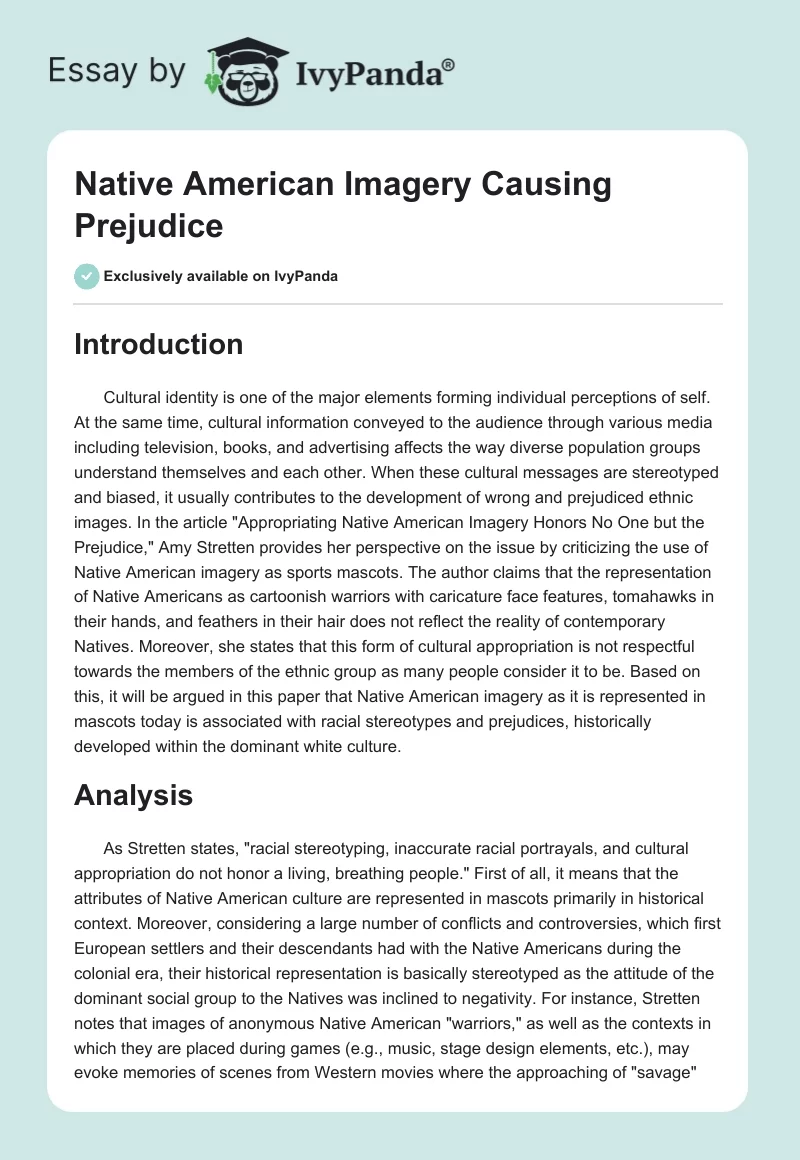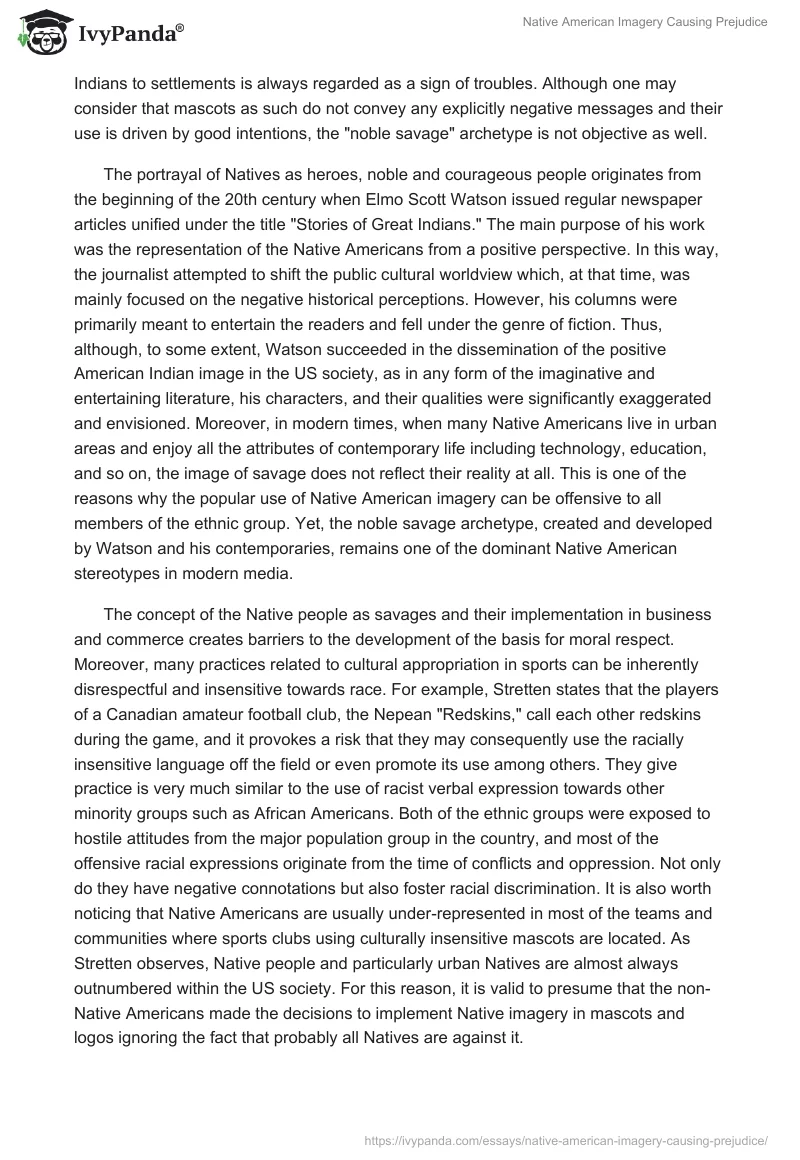Introduction
Cultural identity is one of the major elements forming individual perceptions of self. At the same time, cultural information conveyed to the audience through various media, including television, books, and advertising, affects how diverse population groups understand themselves and each other.
When these cultural messages are stereotyped and biased, it usually contributes to the development of wrong and prejudiced ethnic images. In the article “Appropriating Native American Imagery Honors No One but the Prejudice,” Amy Stretten provides her perspective on the issue by criticizing the use of Native American imagery as sports mascots. The author claims that the representation of Native Americans as cartoonish warriors with caricatured facial features, tomahawks in their hands, and feathers in their hair does not reflect the reality of contemporary Natives. Moreover, she states that this form of cultural appropriation is not respectful towards the members of the ethnic group as many people consider it to be. Based on this, it will be argued in this paper that Native American imagery, as it is represented in mascots today, is associated with racial stereotypes and prejudices historically developed within the dominant white culture.
Analysis
As Stretten states, “Racial stereotyping, inaccurate racial portrayals, and cultural appropriation do not honor a living, breathing people.” First, it means that the attributes of Native American culture are represented in mascots primarily in historical context. Moreover, considering the large number of conflicts and controversies that the first European settlers and their descendants had with the Native Americans during the colonial era, their historical representation is stereotyped as the attitude of the dominant social group to the Natives was inclined to negativity. For instance, Stretten notes that images of anonymous Native American “warriors,” as well as the contexts in which they are placed during games (e.g., music, stage design elements, etc.), may evoke memories of scenes from Western movies where the approaching of “savage” Indians to settlements is always regarded as a sign of troubles. Although one may consider that mascots as such do not convey any explicitly negative messages and their use is driven by good intentions, the “noble savage” archetype is not objective either.
The portrayal of Natives as heroes, noble, and courageous people originated from the beginning of the 20th century when Elmo Scott Watson issued regular newspaper articles titled “Stories of Great Indians.” The main purpose of his work was to represent Native Americans from a positive perspective. In this way, the journalist attempted to shift the public cultural worldview, which was mainly focused on the negative historical perceptions at that time.
However, his columns were primarily meant to entertain the readers and fell under the fiction genre. Thus, although, to some extent, Watson succeeded in disseminating the positive American Indian image in the US society, as in any form of imaginative and entertaining literature, his characters and their qualities were significantly exaggerated and envisioned. Moreover, in modern times, when many Native Americans live in urban areas and enjoy all the attributes of contemporary life, including technology, education, and so on, the image of the savage does not reflect their reality at all. This is one of the reasons why the popular use of Native American imagery can be offensive to all members of the ethnic group. Yet, the noble savage archetype, created and developed by Watson and his contemporaries, remains one of the dominant Native American stereotypes in modern media.
The concept of the Native people as savages and their implementation in business and commerce creates barriers to the development of the basis for moral respect. Moreover, many practices related to cultural appropriation in sports can be inherently disrespectful and insensitive towards race. For example, Stretten states that the players of a Canadian amateur football club, the Nepean “Redskins,” call each other redskins during the game, and it provokes a risk that they may consequently use the racially insensitive language off the field or even promote its use among others. Their practice is very similar to the use of racist verbal expressions toward other minority groups, such as African Americans. Both ethnic groups were exposed to hostile attitudes from the major population group in the country, and most of the offensive racial expressions originated from times of conflict and oppression. Not only do they have negative connotations, but they also foster racial discrimination.
It is also worth noticing that Native Americans are usually under-represented in most of the teams and communities where sports clubs using culturally insensitive mascots are located. As Stretten observes, Native people and particularly urban Natives are almost always outnumbered within the US society. For this reason, it is valid to presume that the non-Native Americans made the decisions to implement Native imagery in mascots and logos ignoring the fact that probably all Natives are against it.
Conclusion
It is possible to conclude that although the archetype promoted in popular Native American narratives has positive connotations of nobility and courage, it contributes to the consolidation of social stereotypes and discrimination. Therefore, the implementation of cultural and stereotypical information in mascots has multiple negative effects on both the members of the minority ethnic group and the society as a whole. When a person doesn’t have an opportunity to interact with culturally diverse people on an everyday basis, her/his perception of other ethnicities and cultural groups becomes primarily based on the information received through education and media. In this way, by conveying culturally insensitive images during sports games, schools and sports clubs contribute to the development of unreasonable social expectations and cultural miscommunication. Thus, they significantly harm the dignity of the Native American people and their identity.
Work Cited
Stretten, Amy. “Appropriating Native American Imagery Honors No One but the Prejudice.” ABC News, 2018. Web.


